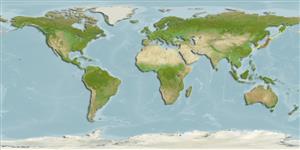分類 / Names
共通名の | 類義語 | Catalog of Fishes(部類, 種) | ITIS | CoL | WoRMS | Cloffa
>
Perciformes/Cottoidei (Sculpins) >
Cottidae (Sculpins)
Etymology: Radulinopsis: Latin, radula, radere = to scrape (1877) (Ref. 45335); taranetzi: Named after the late Anatoly Yakovlevich Taranetz, in recognition of the understanding of boreal fishes and especially cottoid classification (Ref. 45337).
Eponymy: Anatoly Yakovlevich Taranetz (1910–1941) was a Russian marine biologist and ichthyologist who was an eminent expert on Far Eastern fishes. [...] (Ref. 128868), visit book page.
Environment: milieu / climate zone / 深さの範囲 / distribution range
生態学
海 底生の; 深さの範囲 5 - 40 m (Ref. 45347). Temperate
Northwest Pacific: Hokkaido, Japan and Peter the Great Bay.
サイズ / 重さ / 年齢
成熟: Lm ? range ? - ? cm
Max length : 6.0 cm SL オス/雌雄の選別がない; (Ref. 45347)
簡単な記述
検索表 | 形態学 | 形態計測学
背面の脊椎 (合計) : 9 - 11; 背鰭 (合計) : 17 - 19; 肛門の骨: 0; 臀鰭: 18 - 20; 脊つい: 35 - 36. Head and body nearly naked except for lateral line scales and several spiny scales scattered above lateral line; a single tooth band on prevomer; length of anal fin base 39%-44% SL; length of caudal peduncle 8%-10% SL (Ref. 45347). Yellowish brown with four dark brown saddles dorsally; silvery white with reddish-yellow irregular lines ventrally; lower margin of maxilla and branchiostegal membrane black; posterior margin of caudal fin yellow; anal fin black in males (Ref. 45347).
Found over sand or gravel bottoms (Ref. 45347).
Life cycle and mating behavior
成熟 | 繁殖 | 放精 | 卵 | 生産力 | 幼生
Yabe, M. and S. Maruyama, 2001. Systematics of sculpins of the genus Radulinopsis (Scorpaeniformes: Cottidae), with the description of a new species from northern Japan and the Russian Far East. Ichthyol. Res. 48(1):51-63. (Ref. 45347)
IUCNのレッドリストの状況は (Ref. 130435: Version 2025-1)
Human uses
用具
特記事項
XMLをダウンロードして下さい
インターネットの情報源
Estimates based on models
Preferred temperature (参照
123201): 6.6 - 17.4, mean 14.8 °C (based on 16 cells).
Phylogenetic diversity index (参照
82804): PD
50 = 0.7500 [Uniqueness, from 0.5 = low to 2.0 = high].
Bayesian length-weight: a=0.00955 (0.00344 - 0.02648), b=3.09 (2.85 - 3.33), in cm total length, based on LWR estimates for this (Sub)family-body shape (Ref.
93245).
栄養段階 (参照
69278): 3.2 ±0.5 se; based on size and trophs of closest relatives
回復力 (参照
120179): 高い, 15か月以下の倍増期間の最小個体群 (Preliminary K or Fecundity.).
Fishing Vulnerability (Ref.
59153): Low vulnerability (10 of 100).
🛈
